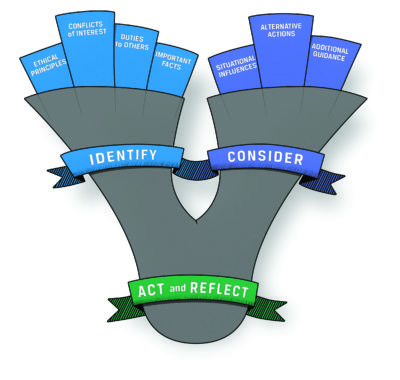Ethics in Practice: Tell Potential Client of Staff Change? Case and Analysis
How did you do assessing whether the CEO in this week’s case (25 June) needed to share about the staff change with the potential client? Analysis is posted below.
It is not unusual for people to leave a firm and pursue other opportunities. But if that person happens to be a key person on a team who was helping pursue a new client, do you have to tell the potential client? Read on and then join the conversation to let us know what you think the CEO should do and what CFA Institute Standard of Professional Conduct applies.
Case
Andersen is the President and CEO of an asset management firm. Andersen and other senior investment managers of his firm make an in-person pitch to manage the investments of a large pension plan. In response to a request from the pension plan, Andersen lists the key personnel that would be involved in offering these services. But while awaiting for the outcome of the evaluation, one of the key personnel that Andersen identified and who was part of making the in-person presentation to the plan leaves the firm. Andersen should
- Hire a competent replacement for the person who left and then inform the pension plan of the change.
- Wait to determine whether the firm wins the business of the pension plan before informing them of the change in staff.
- Immediately inform the pension plan that one of the key personnel has left the firm.
- Do nothing because the pension plan is hiring the asset management firm not an individual.
Analysis
This case relates to CFA Institute Standard I(C): Misrepresentation, which prohibits any knowing misrepresentation relating to professional activities. In this situation, after making the pitch for the investment management business of the pension fund, there is turnover in Andersen’s investment management staff. Andersen has identified the person leaving as a key employee and as a member of the team that made the initial presentation to the pension plan. From Andersen’s perspective, he surely has confidence in the abilities of the firm as a whole and will likely replace the person leaving with a competent professional with similar experience and talents so that there is a seamless transition in services to clients.
Nevertheless, the pension plan is clearly concerned about the particular personnel involved in managing its assets because they asked for that information, which makes C the best response. If this was a junior employee, a staff member who had limited effect on the investment decision-making process, or someone who was not listed as a key employee or who was not part of the team making the presentation, then Andersen may not have to provide an update to the pension plan. But given the circumstances outlined in the case, Anderson must tell the pension plan about the departure of a key staff member to avoid a misrepresentation. Waiting until the replacement is found or until the pension plan makes a hiring decision is too late.
This case was submitted to CFA Institute by an “Ethics in Practice” participant.
Have an idea for a case for us to feature? Send it to us at [email protected].
More About the Ethics in Practice Series
Just as you need to practice to become proficient at playing a musical instrument, public speaking, or playing a sport, practicing assessing and analyzing situations and making ethical decisions develops your ethical decision-making skills. The Ethics in Practice series gives you an opportunity to “exercise” your ethical decision-making skills. Each week, we post a short vignette, drawn from real-world circumstances, regulatory cases, and CFA Institute Professional Conduct investigations, along with possible responses/actions. We then encourage you to assess the case using the CFA Institute Ethical Decision-Making Framework and through the lens of the CFA Institute Code of Ethics and Standards of Professional Conduct. Then join the conversation and let us know which of the choices you believe is the right one and explain why. Later in the week, we will post an analysis of the case and you can see how your response compares.
Image Credit: ©CFA Institute

